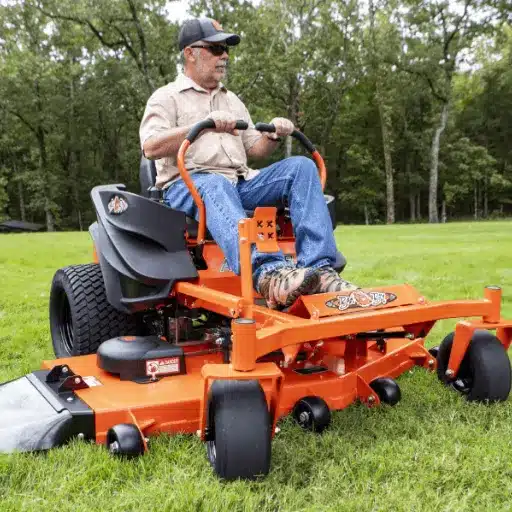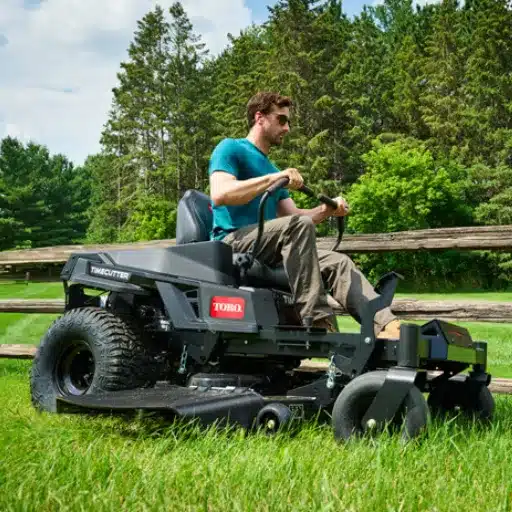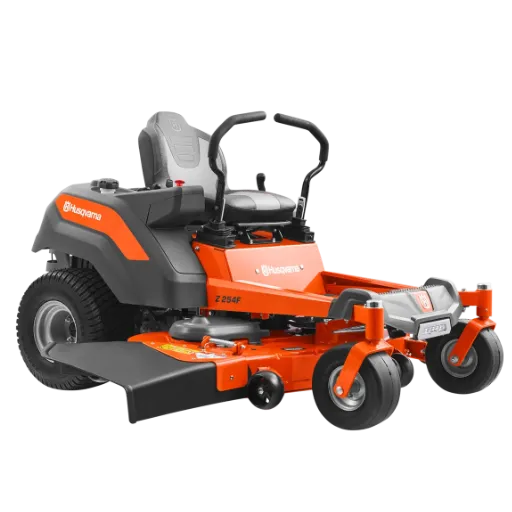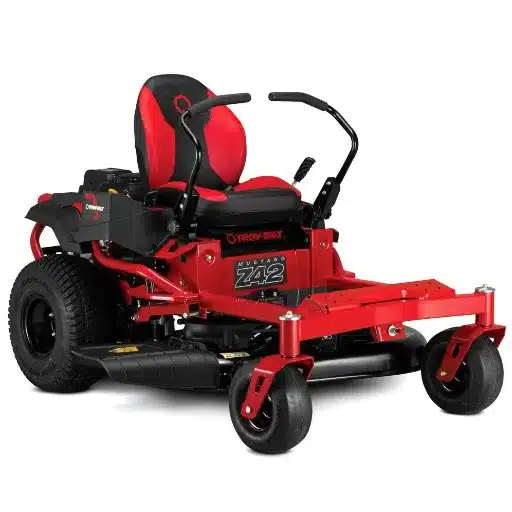Clean lawn and use the right tools; zero-turn machines have been revolutionizing the game when it comes to efficiency and precision in lawn care for homeowners and professionals. Their ability to maneuver with speed has made them the first choice for large-scale properties and complicated landscapes. Such is the variety of choices fighting for your attention that picking any one model can be daunting. This guide will take you through the best zero-turn mowers available today, elaborating on their features, performance, and capacity to satisfy specific needs. Whether you need to enhance an existing equipment portfolio or acquire your first mower, this article will provide the answer.
Introduction to Zero Turn Lawn Mowers

Zero-turn mowers are state-of-the-art machinery aimed at efficient and precise mowing, especially of complicated or very large landscapes. Unlike conventional mowers, zero-turn mowers, with their unique turning radius, allow operators to easily maneuver around obstacles such as trees, flower beds, or fences. This is accomplished through an independent control of the wheels that allows for great agility and handling. These mowers come with powerful engines, large cutting decks, and adjustable features that combine both performance and operator comfort. Time-proven contractors and homeowners alike can benefit from the fast service and almost immediate results that these machines offer.
What is a Zero Turn Lawn Mower?
The control and driving system of a zero-turn mower is fairly unique, operating through two drive wheels that are independently powered by hydraulic transmissions. Because each of the drive wheels can be controlled separately, it gives the mower the ability to pivot along its own axis and, consequently, achieve a zero-degree turning radius. This ability to rotate on its axis gives them greater efficiency and maneuverability when compared with standard ride-on mowers.
The operator typically uses two lap bars or joysticks, allowing for both directional and speed control, enabling extremely complex maneuvers to be executed at will. Powered by heavy-duty engines, these machines can be fast, typically exceeding 7-8 mph, and complete their cutting job in very little time, producing evenly high-quality results. Hydrostatic transmissions, sturdy cutting decks, and adjustable blade heights are some of the technological features that contribute to the mower’s efficiency and adaptability across various terrains and grass conditions. Such technologies render zero-turn mowers absolutely indispensable for large-scale lawn maintenance, where superior mowing, speed, and productivity are essential.
Compare Zero Turn Mowers with Traditional Lawn Mowers
| Parameter | Zero-Turn Mowers | Traditional Lawn Mowers |
|---|---|---|
| Maneuverability | Exceptional, pivots with zero-turn radius | Limited, requires more space for turning |
| Speed | High, up to 8 mph or more | Moderate, around 3-4 mph |
| Cutting Precision | Highly precise, ideal for complex landscapes | Less accurate on intricate terrains |
| Terrain Compatibility | Suited for flat to mildly uneven terrain | Handles uneven and sloped terrains better |
| Ease of Use | Requires practice to master steering | Simpler, easier for beginners |
| Deck Size Options | Wide range, up to 60 inches | Smaller, typically less than 30 inches |
| Time Efficiency | Faster, reduces mowing time significantly | Slower for large areas |
| Cost | Higher initial cost and maintenance expenses | Lower upfront and maintenance cost |
| Durability | Designed for heavy, frequent use | Limited durability for large-scale tasks |
| Fuel Efficiency | May consume more fuel | Generally consumes less fuel |
| Best Use Case | Large areas, professional landscaping | Small to medium residential lawns |
Benefits of Zero Turn Lawn Mowers

Enhanced Maneuverability
Zero-turn mowers were designed here; smooth pivots allow for a very sharp turning movement, making it easy for the user to navigate around obstacles such as trees, flower beds, and fences.
Time-Saving Performance
Lawn mowers also operate at high speeds, covering great areas more quickly, and significantly reduce lawn maintenance for such large properties.
Superior Cutting Quality
Fitted with top-of-the-line cutting deck designs, zero turn mowers specialize in producing great grounding finishes, reducing missed spots and overlaps during damp operations.
Versatility
Zero turn mowers can be customized with attachments such as baggers, mulchers, or sprayers that go beyond just mowing for almost any landscaper’s needs.
Durability for Heavy Use
With heavy-duty capabilities and capable of harsher operation, zero-turn mowers are made for landowners in need of high excellence.
Increased Efficiency in Lawn Care
Zero-turn mowers bring technological advancements that improve the lawn care processes. Most of these machines are precision-steered in order to flawlessly avoid obstacles, cutting down on the time needed for making difficult maneuvers. Likewise, they feature large fuel tanks and big mowing decks, so each time between refills or stops to empty clippings is lessened. Digital displays or GPS operations maximize effectiveness by providing users with real-time updates on performance and coverage, ensuring that when mowing time begins, users’ experiences are optimized. With the machinery advanced by these features, one can carry out pro-level work with actual minimal time, effort, and downtime.
Precision Cutting for Complex Landscapes
Cutting with extended precision strategies has revolutionized the way complicated landscapes are maintained, considering uneven terrain, complex designs, or diverse species of vegetation. Advanced robotic systems equipped with LiDAR and ultrasonic technologies can accurately map the topology of any landscape, allowing for the calibration of cut heights according to the measured environment. Moreover, the integrated machine learning algorithms analyze the cutting layout and adjust/enhance the efficiency of the coverage, particularly in cases where obstacles such as trees, flower beds, or water features are present. The multi-purpose blade system, primarily made from hardened steel or titanium alloys, ensures the blade’s durability and sharpness, allowing it to be used on every surface condition and provide a good, uniform cut. This precision engineering and adaptive technology significantly reduce the effects of human errors and ensure consistent, high-quality results through the design of even the most complex landscapes.
Ease of Maneuverability in Tight Spaces
Modern landscaping equipment is designed compactly with advanced steering technology to enhance maneuverability in cramped or intricate situations. For instance, zero turn steering systems provide pinpoint control, whereby the operator can just as easily turn around an obstacle with a minimum amount of effort. Additionally, many modern models incorporate ultralight materials and ergonomically designed handles that enhance control and reduce fatigue for the operator during extended use. Research indicates that developments such as all-wheel drive and variable speed settings enhance traction and adaptability when navigating uneven terrain. The most excellent accuracy and efficiency may be achieved by such innovations, particularly under hostile conditions.
Comparing the Best Zero Turn Lawn Mowers

In deciding on the best zero turn mower, one must look at the cutting width, the power of the engine, the maneuverability, and the durability. Many models are hitting the market with cutting widths ranging from 42 to 60 inches, suitable for both residential and commercial purposes, allowing users to mow smaller and larger spaces efficiently. High-power engines from Kawasaki or Briggs & Stratton maintain optimal performance in challenging terrain. Hydrostatic transmission further enhances smoother control with accuracy in the operational procedures. In terms of durability, reinforced steel decks and constituents with longevity are demanded, as these will cut down maintenance costs in the long run. Reliable and high-performance options include the Husqvarna Z254F, Cub Cadet Ultima ZT1, and the John Deere Z530M.
Top Models on the Market
| Model | Engine Type | Cutting Width | Transmission Type | Deck Material | Price Range | User Rating |
|---|---|---|---|---|---|---|
| Husqvarna Z254F | Kawasaki FR Series | 54 inches | Hydrostatic | Reinforced Steel | $3,500–$4,000 | 4.6/5 |
| Cub Cadet Ultima ZT1 | Kohler 7000 Series | 50 inches | Hydrostatic | Fabricated Steel | $3,200–$3,800 | 4.5/5 |
| John Deere Z530M | Briggs & Stratton | 54 inches | Hydrostatic | Welded Steel | $4,500–$5,000 | 4.7/5 |
| Ariens Ikon XD 52 | Kawasaki FR691V | 52 inches | Hydrostatic | Tubular Steel Frame | $3,700–$4,200 | 4.6/5 |
| Toro Titan 60 | Kohler 7000 Series Pro | 60 inches | Hydrostatic | Heavy-Duty Steel | $5,000–$5,500 | 4.7/5 |
Pros and Cons of Each Model
| Model | Pros | Cons |
|---|---|---|
| Cub Cadet Ultima ZT1 | • Excellent build quality • Smooth operation on uneven terrain • Adjustable, ergonomic seating |
• Relatively noisy operation • Limited cutting width options • Deck belt may require frequent tuning |
| John Deere Z530M | • Durable welded steel frame • Superior engine reliability • Precise, high-quality cuts |
• Higher price point • Bulky size for small yards • Lack of advanced suspension system |
| Ariens Ikon XD 52 | • Professional-grade performance • Comfortable padded seating • User-friendly controls |
• May require more maintenance • Slightly heavy for some terrains • Difficult for beginners to master |
| Toro Titan 60 | • Wide 60-inch cutting deck • Heavy-duty steel construction • Powerful Kohler engine |
• Higher cost compared to others • Less fuel-efficient • Requires more storage space |
Unique Features to Consider
Cutting Deck Width
The farther the cut takes the grass in one pass, the more time and land is saved. Large-deck machines, such as the Toro Titan 60, feature a mighty 60-inch deck for use on extensive properties, helping to reduce mowing times. In contrast, the Ariens Ikon XD offers a 52-inch deck, providing a middle ground between maneuverability and output, making it suitable for medium to large lawns.
Engine Performance
This factor essentially divides power from cutting ability and terrain management. For instance, the Toro Titan 60 mows with power and consistency, even during heavy grass cutting, thanks to its large Kohler engine, which is designed for heavy-duty work. Likewise, the Z254 from Husqvarna is paired with a Kawasaki engine renowned for its excellent durability and efficiency under adverse working conditions.
Comfort Features
Operator comfort can increase productivity during lengthy usage. The Ariens Ikon XD 52 and the Toro Titan 60 both feature ergonomically padded seats for comfort and reduced fatigue. Controls are designed for ease of use, even during complicated mowing patterns.
Build Quality
If anything, longevity is a key factor in the operation of motor lawn mowers. The Toro Titan 60 is constructed from heavy-duty steel, ensuring it withstands the rigors of wear and tear. The Husqvarna Z254, meanwhile, is lighter in weight, although it incorporates superior materials to design for both performance and durability.
Fuel Efficiency and Storage
Fuel consumption and storage requirements often vary across models. The Ariens Ikon XD 52 is relatively fuel-efficient, in contrast to the Toro Titan 60, which uses more fuel due to the large V-twin Kohler engine installed in it. On the other hand, the Husqvarna Z254 is designed for compactness, making it easier to store in small spaces, despite lacking a suspension system.
Learning Curve for Beginners
Ease of use continues to have a significant influence, especially among first-time users. Although ranging from simple to extreme in its usefulness, the Ariens Ikon XD 52 is said to pose a much steeper learning curve, requiring much more familiarization time by a first-time user. In comparison, the implementation and somewhat more straightforward design of the Husqvarna Z254 could prove best for a novice.
Key Features to Look for in a Zero Turn Lawn Mower

- Engine Power – A powerful engine ensures sufficient power for cutting as well as increased speed when making rounds on large or uneven areas. Look out for brand-name engines with power enough for your property’s size.
- Cutting Deck Size and Material – The cutting deck size determines the width of the swath, with larger sizes reducing mowing time. In terms of durability, go for decks made from reinforced steel or fabricated deck materials.
- Maneuverability – Great performance in tight turns must be supported by good steering feedback and structured, smooth control from your side, especially when going around trees, flowerbeds, or obstacles.
- Durability and Build Quality – The heavy-duty construction, made with premium materials, is what ultimately gives the mower a long life. Concentrate on sturdy frames that use components resistant to rust.
- Comfort Features – Navigating large areas can be quite demanding. Hence, ergonomic seating, vibration reduction, and adjustable controls will add to comfort during extended use.
- Ease of Maintenance – Reaching and cleaning the engine components is a more straightforward task; hence, the system enhances continuous performance with ease.
Engine Power and Performance
The power of the lawn mower determines the capability and efficiency of the cut, especially when the mower has to deal with large, uneven planes. For operational efficiency, the power of the engine is rated in horsepower (HP) or cubic centimeters (cc), with power output increasing as one increases in the rating. The majority of modern mowers promise fuel economy, low emissions, and smooth performance by means of overhead valve (OHV) engines. Varying speed settings also allow for application to varying grass types and conditions for utmost precision. Generally, high-torque engines cut dense or wet grasses and maintain cutting performance consistency through the engineers’ design. Keeping a record of engine specifications is beneficial to better balance the needs of properties versus mower power, fuel consumption, and operational efficiency.
Cutting Deck Size and Design
Performance is affected by the size and design of the cutting deck. Lawn mowers with cut widths ranging from as narrow as 16 inches to wider than 60 inches are designed for different property sizes. Weed about 20 inches is highly maneuverable and is ideal for intricate landscaping or tight spaces. On the other hand, the larger decks are used for commercial purposes or huge lawns where a bigger cut swath translates into less actual time in mowing.
Design innovations also become relevant in optimizing performance. A deck constructed of durable commercial steel or corrosion-resistant alloys ensures it will be put to lasting service against wear and tear. Other features, such as multi-blade systems combined with airflow optimizations, lift grass blades upright, allowing them to be cut cleanly and evenly. They can also be adjusted in height for greater versatility, allowing for different grass types and seasonal maintenance requirements. Correctly choosing a cutting deck should be a compromise between the demands of the property terrain and lawn size on one side, while maneuverability on the other, to guarantee that performance is maximized with low energy consumption.
Durability and Build Quality
When durability and construction quality are being assessed, the nature of materials used in building the lawn mower is of primary importance. The cutting deck and frame are often made from high-strength steel or reinforced aluminum alloy to achieve the purpose of resisting corrosion, impact, and wear as long as possible. Additionally, powder-coated finishes are used as protective coatings against weather factors, including moisture and UV exposure, that would normally degrade the finish over time. Structural threeorities, such as welded joints and bracing, are given extra attention to ensure stability under abuse, particularly on uneven terrain or lengthy use. Bearings, fasteners, and other mechanical parts should be made from hardened materials that minimize degradation and maintain performance in demanding environments. The presence of updated vibration-dampening mechanisms would considerably add to durability and operator comfort. This reduces internal stresses to the system and increases the functional life of the components. By focusing on these considerations, manufacturers can achieve maximum reliability and efficiency, thereby increasing the print time of mowing systems to meet modern landscaping demands.
Buying a Zero Turn Mower

When buying a zero-turn mower, consider your specific needs, with the size and terrain of your property being of utmost importance. For larger flat areas, wider cutting decks of at least 50 inches are recommended for speed. For uneven or sloped terrain, models with high-traction tires and stability features should be your top choice. Engine power is also equally important; a heavy-duty engine of around 22-27 HP will handle more serious jobs. Comfort features, such as ergonomic seating and intuitive controls, can enhance usability, while reliable warranties and accessible after-sales support ensure long-term value. Continually evaluate reputable brands and check customer reviews to ensure performance and durability align with your requirements.
Assessing Your Property Size and Landscape
Regarding size and landscape, one should consider both acreage and terrain features. Large properties require higher-capacity equipment with wider cutting widths and large fuel tanks to carry out operations over long periods efficiently. Smaller properties might require more compact versions that are highly maneuverable. Also, keep in mind the features of the landscape, such as slope, soil type, and dense vegetation or obstacles that might be anywhere. Higher torque and stability-induced equipment may be needed for slopes, whereas specialized tires are best suited to give traction in the case of sandy or heavy clay soils. Accurate mapping of these factors will enable the selection of the best gear among possible choices, thereby providing improvements in performance, safety, and operational efficiency.
Setting a Budget for Your Purchase
A rational budget will lay the foundation for any efficient decision-making process regarding the purchase of machinery. Start by reviewing industry trends and price data to establish a price range that is usual for the equipment under consideration. Subsequently, weigh the costs of equipment maintenance, along with daily operational costs; these, and even possible upgrades, may significantly affect the value of an investment over time. Price comparison is also essential, searching both between manufacturers and suppliers alike, to identify those options where one would stand to gain more through warranties, bundled packages, or financing options. Equipped with this financial backdrop, buyers will be able to strategize the deployment of resources in a manner that ensures the selected equipment receives due attention in terms of both performance and cost-effectiveness.
Understanding Your Usage Needs
Understanding your needs for equipment use begins with a rigorous analysis of the operational requirements and purposes for the selected equipment. Determining the core functions, weight-bearing limits, and environmental parameters will establish the order of priority for characteristics essential to the ultimate efficiency of performance. On the other hand, industrial users may emphasize high endurance under stress, while laboratory users may require precision for handling delicate processes.
Besides, staying up-to-date on technological developments in their fields will ensure that the solutions are modern and increase productivity. Utilizing the most recent data sets and analysis tools enables decision-makers to project expected results and identify effective options to optimize workflows and reduce resource allocation to downtime caused by outdated systems. Application settings also avoid redundancies by ensuring the smooth integration of equipment into existing infrastructure, with consistent performance, while keeping costs at a minimum.
Reference Sources
-
Working Progress towards Lawn Mower Automation
- Key Findings: This study explores the automation of the Spider Lawn Mower (SLM), a four-synchronized steering wheel mobile robot. It highlights advancements in autonomous navigation and control systems for efficient lawn mowing.
-
Algorithm for Optimal Path Planning of a Robotic Lawnmower
- Key Findings: This paper addresses the challenges of path planning for robotic lawnmowers, proposing an algorithm to optimize mowing paths and reduce operational time.
Frequently Asked Questions (FAQs)
Q: How do I choose the right zero turn mower for my needs?
Q: What features should I look for in a riding mower?
Q: Are there electric zero-turn mowers available?
A: Yes, the electric zero-turn mowers are gaining popularity for their environmental advantages and less noise generation. Such machines are powered by strong batteries, which support the longest mowing work while keeping maintenance costs low compared to gas engines. Although the electric models may fall short of their gas counterparts in range, improvements in battery technology are enhancing their capabilities. They are great for noise-sensitive residential lawns. Since brands are jumping into the arena in significant numbers, the latest generation of electric zero turn lawn mowers is perfectly worth checking out.
Q: What is the typical cutting width for a zero-turn lawn mower?
A: The cutting width for zero-turn lawn mowers typically ranges from 42 inches to over 60 inches, depending on the model. A more expansive cutting deck is beneficial for larger lawns, as it allows for faster mowing and fewer passes. If your lawn has many tight corners, though, I’d say a smaller width would be more suitable. Therefore, analyze how the zero-turn mower cutting width will affect your mowing efficiency and time spent on lawn maintenance. From Scag to Toro, these brands offer a range of solutions for every lawn size and type.









